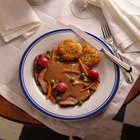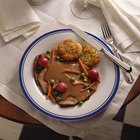
It's relatively easy to judge the doneness of a steak, either by watching the meat change color at the edge or by pressing it with a fingertip to assess its firmness. For a roast such as a ribeye, the larger size of the cut means those tactile and visual cues aren't available. Recipes typically provide a rough guide, based on weight and cooking time, but the only way to really know when your ribeye is perfectly cooked is by using a thermometer.
Step 1
Trim any loose pieces of fat or connective tissue from the surface of your ribeye with a sharp knife. Look at the ends of the roast to see whether its shape is cylindrical or relatively flattened and oblong. An oblong roast cooks more evenly if you tie it tightly, approximately every 2 inches, with cotton butcher's twine. This makes it cylindrical so the heat penetrates the meat at the same pace from all directions.
Step 2
Season the surface of the roast liberally with salt and pepper or with your choice of dry or paste flavorings. At this stage you can cook the roast immediately or cover and refrigerate it overnight so the flavors of your spice rub can mature and infuse into the meat.
Step 3
Preheat your oven to 225 degrees Fahrenheit. Place the seasoned ribeye in your roasting pan and insert the probe of your thermometer into the middle of the thickest muscle. Slide the roast into your oven, positioning the thermometer's cable near the top of the oven door.
Step 4
Plug the thermometer's probe cable into the display and power it up. Set your target temperature for 10 to 15 degrees below your preferred level of doneness. For example, if you want medium-rare beef at 130 to 135 F, set the thermometer to alert you when it reaches 120 F.
Step 5
Slow-roast the ribeye until you're alerted by the thermometer's tone, roughly 3 to 4 hours, depending on the size of the roast. Double-check the roast's temperature with an instant-read thermometer, because the metal probe of a digital thermometer can conduct heat into the meat and report a temperature that's slightly higher than the rest of the roast.
Step 6
Pull the roast from your oven and let it rest under a loose covering of foil for up to 30 minutes as its temperature rises to the desired doneness. Turn your oven up to its maximum temperature, usually 500 F, about 10 minutes before you're ready to serve the meal. Return your roast to the oven for 8 to 10 minutes; this browns the surfaces and creates rich, savory flavors. Transfer the roast to a serving platter and take it to the table.
Related Articles

How to Cook Prime Rib Using an Oven ...

How to Prepare Chuck Tender Roast
Cooking Guide for Semi-Boneless Beef ...
How to Cook a Spencer Roast

How to Use an Electric Roaster to Slow ...

How to Cook a 15-Pound Rib Roast
How to Cook a Standing Rib Roast on a ...

How to Convection Roast a Brisket

How to Cook Texas Broil Roast

How to Cook a Standing Rib With the ...

How to Cook a Beef Roast in a Roaster ...

How to Cook Boneless Beef Chuck Medium ...

How to Cook an 8- to 10-Pound Beef ...
The Best Way to Cook Four Pounds of ...

How to Cook a Beef Topside Roast

How to Cook Deep Pit Beef in a Roaster ...

How to Marinate a Top Round Roast

How to Grill a Ribeye on a Weber Q

How to Make a Blackbuck Antelope Roast

How to Bake a Pork Loin Center Half
References
Tips
- If you don't have a digital probe thermometer, use a traditional leave-in thermometer and position it so you can clearly read its dial without opening the oven. Check it periodically through the first two hours of cooking time, then frequently during the last 30 minutes to one hour.
Warnings
- Ribeye is usually served medium-rare, at around 130 F, but the USDA's food safety guidelines recommend cooking all fresh meats to a minimum of 145 F. Diners whose immune systems are compromised by age or illness should lean toward caution and avoid undercooked beef.
Writer Bio
Fred Decker is a trained chef and prolific freelance writer. In previous careers, he sold insurance and mutual funds, and was a longtime retailer. He was educated at Memorial University of Newfoundland and the Northern Alberta Institute of Technology. His articles have appeared on numerous home and garden sites including GoneOutdoors, TheNest and eHow.
Photo Credits
Jupiterimages/Photos.com/Getty Images